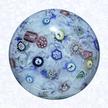French Manufacturers -- Baccarat
<.h2>Baccarat Glass Factory

Baccarat Factory
Nineteenth-century Postcard
Courtesy of Pascal OllagnierIn 1764, the Bishop of Metz, wanting to put his land to commercial and economic use, petitioned Louis XV for permission to set up a glass factory that would use the timber in its wood-burning furnaces, and create competition for the imported Bohemian glassware. Wood could be floated on the river, so the town of Baccarat was chosen as the site of the factory.

baccarat
The Bishop went into partnership with a glassmaker named Antoine Renaut and the financial backing of neighboring landowner Leopold Corny. The Verrerie Renaut was established with living accommodations for seventy workers and their families. Workers were on call because of the unpredictability of firing temperatures. The company was renamed the Verrerie de Baccarat in 1768 and the Verrerie de St. Anne in 1773.
It prospered until the turn of the century, when warfare of the Revolution and First Empire caused it to be auctioned off. It became Verrerie de Baccarat in 1816 with its new owner, Aime-Gabriel d'Artigues, who also owned a glass factory in Belgium. By then the factory was manufacturing lead crystal. In 1823 another set of new owners set up standards of production that added to the factory's reputation. The next year a pump was invented that simplified the blowing process. Colored glass was introduced in the plant in 1838.

Magnum Spaced Millefiori
Baccarat (signed), dated 1848In 1845 the director of the Baccarat factory and the director of the St. Louis factory traveled to Vienna to the Exhibition of Austrian Industrial Products and brought back the idea of making millefiori paperweights, which Baccarat begins to produce the next year. During the economic depression of 1848-1852, only one of the factory's furnaces operated. Paperweight production was at its peak from 1846 to 1855.










